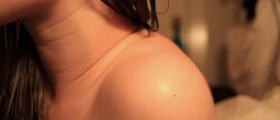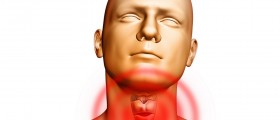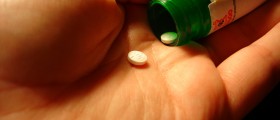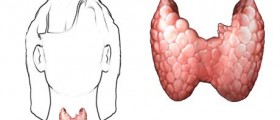
Most of the lumps found on thyroid gland are of benign nature, while only 5% are diagnosed to be malignant changes. Thyroid adenoma and cysts, as well as thyroiditis and hyperplastic nodules of the thyroid gland are commonly associated with benign thyroid lumps. This condition is more common among women and there is about 8% of general adult female population suffering from benign nodules found on thyroid gland, but just 2% of men are diagnosed with this problem. This problem is fairly rare in children, but girls are also more likely to develop this condition than boys.
Symptoms of Benign Thyroid Nodules
In many cases, benign lumps on thyroid gland don’t cause any symptoms and these patients are known as asymptomatic. Patients tend to notice the lump(s) in the area of thyroid gland when looking in the mirror. Also, members of a patient’s family may see the change and lump on thyroid gland.Sometimes, thyroid lumps could cause pain or result in trachea compression. Thyroid gland may enlarge evenly or asymmetric, depending on the size of the lump. Patients could experience some tenderness and swelling of lymph nodes in the affected area of the body.
Your doctor will want to feel and touch your neck and thyroid gland, in order to determine the size and asymmetry of the nodules and tenderness (if present). Also, he or she might check for regional lymphadenopathy and examine your neck while you are swallowing some water.
Related Medical Conditions
There are several possible reasons for development of non-malignant (benign) thyroid nodule, including medical problems such as non-toxic goiter, toxic nodular goiter and overactive thyroid gland (Grave’s disease). Benign nodules on thyroid may also appear in: autoimmune destruction of thyroid gland (Hashimoto’s disease), thyroiditis due to some upper respiratory or viral infection (De Quervain thyroiditis) or cue to some bacterial or fungal infection and consequent abscesses (acute supurative thyroiditis). Sometimes, possible explanation of benign nodules on thyroid gland may be solitary thyroid nodule.
Diagnostic Procedures
The most commonly used methods for diagnosis of the nodules found on the thyroid gland are thyroid function test and ultrasound (US). US can show very small nodules on thyroid gland, even those that your doctor can’t notice touching your neck and thyroid gland.
Fine needle aspiration (also known as FNA), radionuclide imaging and CT (computed tomography) and MRI (magnetic resonance imaging) scans are also frequently used to diagnose problems with thyroid gland.

















Your thoughts on this
Loading...